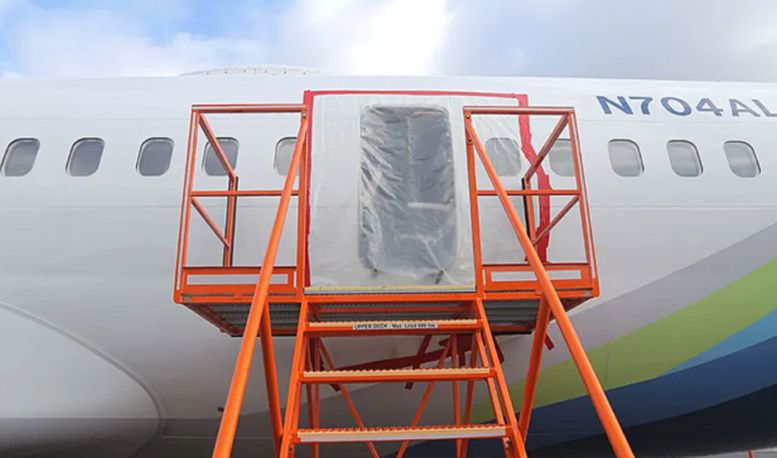Bia Lacombe is a member of Socialist Alternative in the US.
In early January, in a near disaster in mid-air, an Alaska Airlines flight of a Boeing 737 MAX 9 was forced to make an emergency landing after a side “door plug” ripped off the plane. Passengers reported being sure they were going to die. Just by chance, no one was sitting near the door, the plane was not at maximum altitude, and the flight crew responded quickly —otherwise there would likely have been casualties. This came just a few days after flight crews saved the lives of 380 people after a collision at the Tokyo airport.
Since the incident, the Federal Aviation Administration, (FAA)O, has grounded all Boeing 737 MAX 9 planes for further investigation and inspection. It’s not even the first time the 737 MAX has been grounded: this plane, and the executives who have profited handsomely from it, caused the deaths of over 300 people in 2018 and 2019. As Alaska Airlines, and United Airlines, have recently inspected their Boeing MAX 9 planes, they’ve reported finding loose bolts on a number of them.
This news has exposed and brought attention to a wider breakdown which implicates not just Boeing executives, but the entire aviation industry, including federal regulators. It’s just the latest symptom of a system in complete crisis.
Perhaps the most jolting statistic illustrating this disastrous situation is the one reported by the New York Times last summer. After analyzing a NASA database that contains confidential safety reports filed by pilots, air traffic controllers and others in aviation from 2022, a study showed that there were close to 300 instances of near-collisions involving commercial airlines in domestic US flights! Two such near misses occurred last July within ten days of each other. They were such dangerously close shaves that the FAA’s internal records reviewed described the two encounters as “skin to skin.”
Aviation corporations, from airlines to aerospace manufacturers, put profits first and the needs of workers and passengers last. Rather than take responsibility for the disastrous results of putting profits before safety, aviation corporations are quick to blame flight crews for anything that goes wrong with a flight.
There have been numerous media reports of the crisis faced by flight attendants, air traffic controllers, pilots, ground crew, and workers in the Transportation Security Administration (TSA). The widespread mental health issues faced by pilots received major headlines in October when pilot Joseph Emerson was charged with trying to crash an Alaska Airlines flight. Pilots, air traffic controllers, and others in the industry have reported lying about mental health problems so that they don’t risk their jobs.
This industry-wide crisis has grown under both Democrats and Republicans, who gladly underfund regulatory agencies like the FAA while giving enormous tax breaks to wildly profitable companies like Boeing. In Washington State, in 2013, Democratic Governor Jay Inslee and Democratic-controlled legislature gave Boeing a whopping $8.7 billion in tax breaks to supposedly keep jobs in the state. But Boeing dramatically cut jobs anyway: by 2017, they had cut 12,655 jobs, or more than 15% of its Washington workforce.
Boeing Cuts Corners with Deadly Consequences
In 2019, Ethiopian Airlines Flight 302 crashed and all 157 people on board were killed. Just a few months earlier, in 2018, Lion Air Flight 610 crashed near Indonesia and killed 189 people. These two flights were both operating Boeing 737 MAX 8s, and the story of this plane helps expose the rot at the center of this and other capitalist industries with their never-ending race for profits.
The two biggest airplane manufacturers in the world are Airbus and Boeing, and they are longtime rivals. In 2011, Airbus announced a new type of engine on their popular domestic, shorter-range aircraft that would save fuel, and therefore lots of money, for commercial airlines. It was a big success. Boeing, frantic to keep selling more planes than Airbus, raced to upgrade the engine on their domestic plane, and called it the 737 MAX.
Because of the way the Boeing plane was originally designed over 50 years ago, they had to place the new engine higher up on the wing. They used software to stabilize the unstable design. To reduce training time (and costs) Boeing didn’t tell pilots about this software, and didn’t include it in any manuals. When the software malfunctioned and pushed planes down until they crashed, pilots couldn’t figure out how to stop it in time.
Besides bad headlines and lost sales, Boeing faced almost no consequences. No executives went to jail, the FAA helped them recertify the airplane as quickly as possible, and even intimidated whistleblower workers who continued to raise alarms about the process that led to these disasters.
The Lever recently reported about a federal court filing against Spirit Aerosystems, the Boeing subcontractor that reportedly built the door panel that blew out on the Alaska flight, where employees allege that they repeatedly warned corporate officials about safety problems and were told to falsify records. Workers allege that they were told to misrepresent the number of defects in their products, and that workers who raised concerns were demoted or moved to different positions.
The lawsuit also argues that the FAA has failed to properly regulate companies like Spirit, which instead was awarded a $75 million public subsidy from Pete Buttigieg’s Transportation Department in 2021.
Aviation Workers Pushed to the Brink
Workers in every part of the industry, from those who build the planes to those who fly them, care about passenger safety and want to do their jobs to the highest standard. But they’re forced into crushing working conditions that make this virtually impossible — all so their company’s wealthy executives and shareholders can get even wealthier.
A New York Times investigation last month revealed how a “nationwide shortage of air traffic controllers had resulted in an exhausted and demoralized workforce that was increasingly prone to making dangerous mistakes.” According to the Times, “Air traffic controllers and others have submitted hundreds of complaints to a Federal Aviation Administration.” They reported that virtually all US air traffic control sites were understaffed, forcing controllers to work 10-hour days, six days a week.
Pilots face similarly enormous pressures, leading many to also develop physical and mental health problems. Many have quit or turned down promotions that would lead to unpredictable flying schedules. There is now a massive pilot shortage: there are around 18,000 fewer commercial pilots than the industry needed in 2023.
Chronic financial distress has been the norm for many flight attendants, with wages so low they often qualify for food stamps and other public assistance. Many have to sleep in cars while on call for a shift, a call that may or may not come. As the Seattle Times reported last month, two Alaska Airlines flight attendants started a private Facebook page titled “Alaska Airlines FAs experiencing hunger and homelessness.” The group shares countless stories of financial problems facing flight attendants, and tips on where to get free food in the cities to which the airline flies.
Working-Class Fightback Needed to Fundamentally Change the Industry
Whether it’s defending the lives of passengers, or improving the wages and working conditions of the workers, any change in this industry can only come from an organized working-class fightback. Aviation workers are fed up with deteriorating, dangerous conditions, and they’re getting organized.
On February 13, flight attendants will hold a day of action at over 30 airports worldwide. More than two-thirds of the US flight attendants are currently in contract negotiations, including contract fights at American, Alaska, United, and Southwest. Recently, flight attendants at Southwest Airlines rejected a tentative contract agreement, with 64% of them voting against the proposed five-year deal.
On January 13, Brussels Airlines pilots held a wildcat strike over benefits that haven’t kept up with inflation. In May of last year, 99% of the rank-and-file members of the Southwest Airlines Pilots Association voted to approve a strike mandate for the first time in the company’s history, with 98% of members participating in the vote! At the end of January, pilots voted by 93% for a new contract that will raise wages by nearly 50% over seven years and increase retirement benefits.
In September, an overwhelming 99% of American Airlines flight attendants voted to authorize a strike, with over 93% participating in the vote. American Airlines is operated by over 26,000 flight attendants unionized with the Association of Professional Flight Attendants, who are demanding better pay and working conditions against the corporation’s reported $1.3 billion profits in the second quarter of last year.
The Teamsters in the US are currently forming a coalition to unionize over 50,000 workers at Delta, including ramp, tower, and cargo workers, flight attendants and mechanics.
This year, the contract will expire for Seattle-area Boeing machinists unionized with IAM District 751. According to one worker, they’re fired up to win the cost-of-living increases they’ve gone more than ten years without, including preparing for a strike.
Air travel that is so integral to public infrastructure and safety like Boeing, Spirit Aerosystems, and even all the airlines, aren’t safe in the hands of the billionaires. It’s the workers who know how things should be run, and it’s the workers who want to do their jobs well and keep people safe. Workers need to take these companies into democratic public ownership and run them in the public interest, with the whole industry organized democratically.




